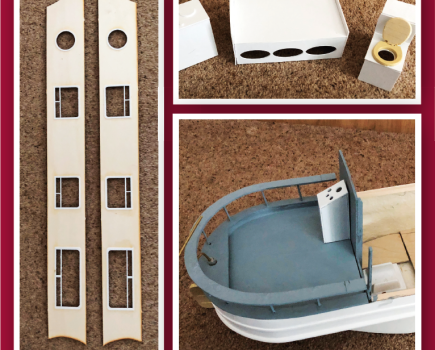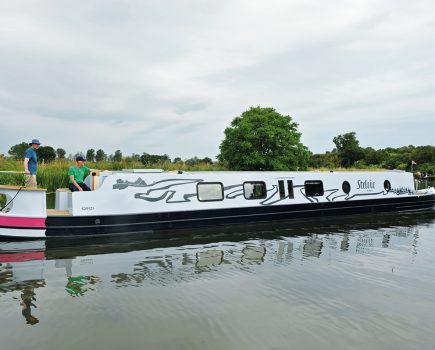Meet Kit Acott, a medical herbalist whose cancer diagnosis brought out incredible courage and a determination to live the good life, thanks to her floating garden

Hearing the words, ‘You’ve got breast cancer,’ is not high on anyone’s wish list, but for Kit Mattingly to even get to this point was a battle. Kit, and her partner Mike, are continuous cruisers. Until this year, they did not have a home mooring which in turn meant that they did not have a postcode. Living off grid is an integral part of Kit and Mike’s lifestyle and they work hard to make sure they live as carbon neutrally as possible.
The only real problem with living as they do has been the inaccessibility of healthcare. As a medical herbalist, Kit worked closely with the medical establishment for many years, but when she came to try and access it for herself, she encountered all manner of difficulties. The NHS website is very clear that ‘You are entitled to register in the area where you are, without ‘proof of address’. Sadly, this was not Kit’s experience, rather, it was a process she describes as ‘soul destroying’. Battling with receptionists about her right to be there, and in front of a packed waiting room, Kit had to give intimate details of her breast lump. There was no confidentiality, rather Kit was left embarrassed and distressed.

Is it any wonder that many are driven to lie and to use the addresses of friends or relatives in order to avoid this sort of encounter?
Kit finally prevailed but is very sure that her late diagnosis led to a more advanced cancer than would have otherwise been the case.
The lack of postcodes for continuous cruisers means that it is impossible to access screening programmes. They are entitled to see a GP if they persist as Kit did, but without the magic postcode, bowel screening, mammograms, smear tests, and the like, remain closed to them. Therefore, in Kit’s case, what may have shown up on a mammogram earlier, was left unchecked. Being conscientious continuous cruisers means that Kit and Mike have always stayed within the terms of their licence and have, as stipulated by CRT, ‘moved from place to place over a total range of 20 miles or more rather than just shuttling back and forth between two or three places’.
In fact, prior to Kit’s illness their route took them regularly between Manchester and London and since then, their travels still well exceed 300 miles per year. Unfortunately, remaining compliant with one set of legislation puts you at odds with healthcare providers and Kit is not alone at failing to get the health care she needed in a timely manner.

However, you can’t keep a determined woman down, and Kit is nothing if not determined. While recovering from surgery, she began planning for a future that would involve keeping as fit and healthy as possible. According to Cancer Research ‘the food we eat can affect our risk of developing cancer, both directly and by helping us keep a healthy weight.’
For Kit, this meant lots of fresh fruit and vegetables of the organic variety. The easiest way to get hold of organic veg is to grow your own but the amount that Kit wanted was never going to work with the just usual rooftop boxes that adorn many narrowboats. Gradually, the idea of a garden butty was born.
After all, if you can’t dig up your garden, pulling it along behind you (or rather pushing it in front of you) must be the next best thing.
The convalescent hours spent on the ‘fainting couch’ that Mike had lovingly made for her, enabled Kit to sketch out her ideas of a floating garden. These first sketches were sent to Paul Barber of PJ Barber Boat Builder Ltd, allowing him to use them as a base from which to create Hortus. “We thought about issues, e.g. the small engine [on Gyptian] was a major concern, so we came up with a swimable design,” explained Paul. Kit and Mike’s motor boat, Gyptian is a tiny 30ft narrowboat powered by a 1973 two cylinder, air-cooled Lister SR2 engine.

Because of this, Paul felt that creating a low-drag shunt boat would be much more practical than towing a butty. Kit leapt at this idea with alacrity as one of Mike’s dreams had always been to have a shunt while the whole towed butty idea was leaving him cold. With this decided upon, the rest fell into place; 25ft Hortus would be held on rigidly to Gyptian’s bows with giant bottle screws in a permanent arrangement so that the two boats together would operate as one.
Next, building a boat that would be easy for Gyptian to push was imperative so instead of the usual narrowboat hull shape of a flat base plate for the whole of the 6ft 10ins width, Hortus has a more leaf like shape under the water with a flat base plate of just one metre wide and sculpted chines giving her a streamlined profile and an organic feel. Something that pleases Kit immensely. The very practical purpose of this unusual design is to allow Hortus to be pushed through the water by Gyptian with ease.
Their first journey back to the newly acquired home mooring in Wolverhampton from Paul’s boatyard near Nottingham, involved taking Hortus onto the Trent – something that caused Kit a few sleepless nights. But she needn’t have worried.
Travelling with the two boats shunted together was very straightforward. “They feel like one boat,” Kit explained, with no extra pressure felt by the engine, no extra fuel consumed, and in no way tippy. In fact, together, Hortus and Gyptian felt surprisingly stable and exactly the same as Gyptian alone.
Obviously, not all of Hortus was destined to be below the waterline. The hold area is where the main growing action is happening. Supported by a network of steel cradles are a row of raised beds created from bright blue upcycled 120 litre drums which line each side.
The drums are lined with pumice to conserve water and filled with organic compost. A variety of upright pipes, upcycled of course, allow for watering at root level. The 18ins metal top plank has several eyelets from which to hang tubs and containers as well as a washing line for the traditional butty way of drying clothes.
Here also, the curtain sides are suspended. These are an important part of the success of Hortus as a garden and can be opened or closed to suit, similar to a curtain-sided lorry. Made from PVC shower curtain material, the curtain sides allow the sunlight through while keeping off the worst of the weather so the delicate seedlings can flourish. They effectively turn the whole hold into a cold greenhouse. When drawn open, they are wrapped in canvas to protect them from UV light thus extending their life. The gunwhales have a metal upturned lip which the bottom hem of the curtain sits over to allow water to run off, while the base of the curtain secured behind.
The organic seeds are brought on in the greenhouse section which has been created in the bows. Paul’s beautiful steelwork needed to have holes cut into it which caused a few heart stopping moments but with some skilful angle grinding, recycled Perspex was added to create two rectangular windows in the sides and three panels in the roof.
Finally two portholes were cut into the port bulwark. Shelving allows the seed trays plenty of growing space, while the compost bin and wormery sit snugly on the floor.
At the opposite end of Hortus, is part of the boat that really excites Kit and where she envisages making Hortus earn her keep. It is a little kitchen and serving hatch, to be fitted out steam punk style with recycled brass fittings aplenty. Three sides are lined with work surface or shelving, giving Kit a small work area with everything in easy reach. The plan is to sell hot drinks and snacks so the kitchen will be fitted out accordingly. A small spirit stove will heat a gorgeous samovar for drinks and the LED lighting in funky metal fixtures will tap solar powered batteries, as will the electric cool box.
Solar panels sit on the roof of Gyptian keeping the batteries charged with an umbilical connection which will also be used by the recycled Morco boiler to provide hot water for washing up. The extra-large hatch with fold out serving shelf allows customers to see right into the kitchen area.
From here, customers will be able to order coffee hand ground in an 1896 Peugeot bistro grinder and brewed anyway they like. Also available will be all manner of teas and herbal tisanes, served in your own mug, one bought from Kit, or a compostable cup that if left at Hortus will be turned back into compost and used for future plantings.
The whole of the Hortus project was one that the boating community took very much to its heart.
Her steel was crowdfunded and much of the hard work gone into creating her has come about with friends donating time, energy, seeds, equipment, and love. Raising crops in this way has inspired many to follow Kit’s adventures which she blogs about at Hortus, Kit’s Garden Boat and to even think more creatively about how they are garden while afloat.
If Hortus’s creation also means more people are aware of the potential conflict between health care screening and continuous cruising then Kit will be a happy woman indeed.
Editor’s note: DO check out Kit’s Facebook page…you’ll be amazed
Image(s) provided by:
Archant







